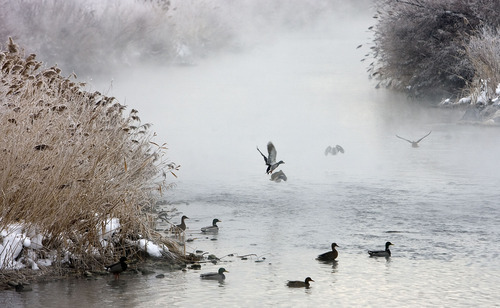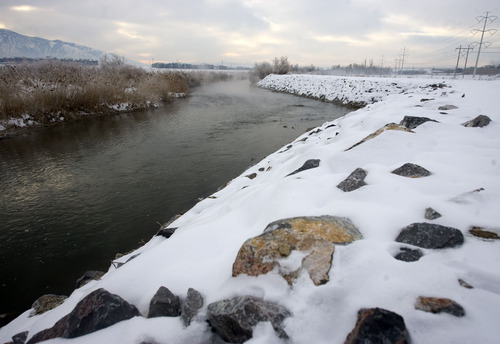This is an archived article that was published on sltrib.com in 2011, and information in the article may be outdated. It is provided only for personal research purposes and may not be reprinted.
The Midvale slag Superfund site cleanup is in its final phase, now that crews have built up and reinforced the banks of the Jordan River and replaced an old, defunct dam.
All that's left to do is a little more tidying up before willows and other vegetation can be planted when the weather warms up.
The river restoration between 6400 South and 7800 South, mandated by the U.S. Environmental Protection Agency's overall plan for cleaning up heavy-metal contamination of old smelter sites in Midvale, required intermittent closures of the riverside trail.
Ray Limb, EPA's Midvale project coordinator, said the trail section between 7200 South and 7800 South, which had been closed since around Thanksgiving, is again open to pedestrians and cyclists.
"If we keep the banks so they don't erode," Limb said, "then the river is being protected against potential contaminants."
The area was farmland until the late 19th century, when more than 30 smelters were built to refine ores from Park City, Tintic and Bingham Canyon. Farmers sued the smelters claiming the pollution was ruining crops and making animals sick. By 1945, scientists found arsenic from the smelters had killed just about all of the bees on the Wasatch Front. The last smelter shut down in 1947.
The EPA began its studies of the site in the early 1980s and listed the site, divided into two portions, for Superfund cleanup in 1990 and 1991. By the end of the decade, the slag was capped or cleaned up.
The Jordan River Riparian Improvement project started in fall 2008 as a joint effort of the EPA, the Utah Department of Environmental Quality, Salt Lake County and the city of Midvale.
The riverbanks are now stabilized with boulders. The relic dam from mining days has been rebuilt with rock into a low-head dam that creates a drop — and a short, steep set of rapids — in the river around 7400 South. Portage trails on both sides of the river allow canoers and kayakers to get around the drop safely if they don't want to go through the newly-built boat chute.
Erna Waterman of the EPA said that work could be done by late summer. "The cold has slowed [workers] down, but really, when it was muddy it was worse," she said.
Waterman said the new landscaping would be irrigated. "We probably will need to close the trail for a few days or a week in the spring for the west-bank planting," she said.
The trail, crusty with snow, required a healthy imagination on a cold January morning to envision what that section of the Jordan River will look like this summer.
Salt Lake County public works and flood control workers still have trucks and an excavator on site just south of the TRAX bridge, and hundreds of acres stand empty awaiting construction of housing and commercial developments.
But Mark Hill, a Taylorsville resident and regular ambler on the riverside trail who has floated the river in a sea kayak, could see past the rigs, rock piles, bare dirt and the clammy inversion fog to the sunny future.
"There was a big black pile on the other side of the river. It's turned out way better than I thought," he said. "The river's in a lot better shape." —
The Midvale Superfund project
The U.S. Environmental Protection Agency listed the 446-acre site as a Superfund cleanup project in 1991.
The site, which comprises about 20 percent of Midvale city, with a small portion extending into Murray city, is 12 miles south of Salt Lake City.
Five ore smelters were on the site between 700 West and the Jordan River from 1871 to 1958. The smelters treated ores from Bingham Canyon and other mines. Investigations at the site showed groundwater, the river, the soils and the air were contaminated with lead, arsenic, cadmium and chromium.
The EPA declared the site clean in 2006. By then, chemicals found in an abandoned lab were gone, 20 pounds of explosives were detonated and soils had been excavated from the small, unmarked Pioneer Cemetery.
The last bits of work — stabilizing the Jordan River's banks and planting them with willows and other vegetation to protect the riparian corridor — is scheduled for completion by late summer.





